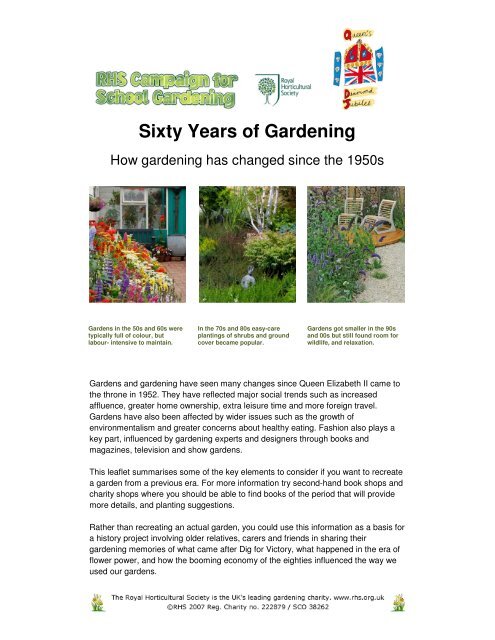Download Sixty Years of Gardening (2970.0KB, .pdf
Download Sixty Years of Gardening (2970.0KB, .pdf
Download Sixty Years of Gardening (2970.0KB, .pdf
You also want an ePaper? Increase the reach of your titles
YUMPU automatically turns print PDFs into web optimized ePapers that Google loves.
<strong>Sixty</strong> <strong>Years</strong> <strong>of</strong> <strong>Gardening</strong><br />
How gardening has changed since the 1950s<br />
Gardens in the 50s and 60s were<br />
typically full <strong>of</strong> colour, but<br />
labour- intensive to maintain.<br />
In the 70s and 80s easy-care<br />
plantings <strong>of</strong> shrubs and ground<br />
cover became popular.<br />
Gardens got smaller in the 90s<br />
and 00s but still found room for<br />
wildlife, and relaxation.<br />
Gardens and gardening have seen many changes since Queen Elizabeth II came to<br />
the throne in 1952. They have reflected major social trends such as increased<br />
affluence, greater home ownership, extra leisure time and more foreign travel.<br />
Gardens have also been affected by wider issues such as the growth <strong>of</strong><br />
environmentalism and greater concerns about healthy eating. Fashion also plays a<br />
key part, influenced by gardening experts and designers through books and<br />
magazines, television and show gardens.<br />
This leaflet summarises some <strong>of</strong> the key elements to consider if you want to recreate<br />
a garden from a previous era. For more information try second-hand book shops and<br />
charity shops where you should be able to find books <strong>of</strong> the period that will provide<br />
more details, and planting suggestions.<br />
Rather than recreating an actual garden, you could use this information as a basis for<br />
a history project involving older relatives, carers and friends in sharing their<br />
gardening memories <strong>of</strong> what came after Dig for Victory, what happened in the era <strong>of</strong><br />
flower power, and how the booming economy <strong>of</strong> the eighties influenced the way we<br />
used our gardens.
If you want to look further back in gardening history, the BBC has a useful, interactive<br />
gardening timeline that starts with the Romans who are credited with bringing the<br />
concept <strong>of</strong> ornamental gardens to Britain. This is the address:<br />
http://www.bbc.co.uk/gardening/design/flash/main.shtml<br />
Gardens in the 1950s and 60s<br />
Emerging from wartime austerity and Dig for Victory campaigns, many ornamental<br />
gardens had been reduced or dug up completely in order to grow food. Much new<br />
housing was also built to replace war damage, so many gardeners were faced with a<br />
blank canvas. Gardens tended to be relatively high maintenance, and gardening was<br />
a popular hobby, supporting thriving flower shows and many specialist plant<br />
societies. Common features <strong>of</strong> 50s and 60s gardens included:<br />
∗ a carefully tended lawn, cut with a manual or petrol-driven lawnmower<br />
∗ crazy paving, making a virtue <strong>of</strong> the lack <strong>of</strong> materials available for gardens<br />
∗ a rockery, <strong>of</strong>ten over-run with rather too vigorous plants such as aubrieta<br />
∗ traditional ornaments such as bird baths and sundials<br />
∗ hybrid tea and floribunda roses, <strong>of</strong>ten grown on their own in special rose beds<br />
arranged by colour, or as standards lining a path<br />
∗ privet hedges, clipped by hand<br />
∗ a vegetable plot with traditional staples such as leeks, cabbages, carrots,<br />
potatoes, cabbages, peas and beans<br />
∗ show flowers such as delphiniums, begonias, sweet peas and chrysanthemums<br />
∗ colourful herbaceous borders featuring plants such as lupins, oriental poppies,<br />
michaelmas daisies and phlox bought from specialist nurseries by mail order<br />
2
∗ bedding schemes in bright colours for example red salvia, blue lobelia and white<br />
alyssum, bought as small plants in trays from greengrocers or ironmongers<br />
∗ chickens where there was enough room<br />
∗ new chemical products to control pests and improve soil fertility<br />
∗ home-made or loam-based potting compost<br />
∗ a garden shed, perhaps with a small, lean-to greenhouse<br />
∗ deckchairs as the commonest garden furniture<br />
Gardens in the 70s and 80s<br />
In this period, more and more people had access to a garden, and garden centres<br />
emerge to meet the demand for quick results with container-grown plants. There was<br />
a boom in TV programmes and gardening magazines <strong>of</strong>fering advice. Lowmaintenance<br />
designs were popular, electric power tools helped make cutting lawns<br />
and trimming hedges quicker and easier. Gardens are seen as places for relaxation<br />
rather than hard work. Common features <strong>of</strong> 70s and 80s gardens included:<br />
∗ island beds cut into the lawn, filled with easy-care, quick-growing shrubs such as<br />
berberis, buddleia, cotoneaster, euonymus, eleagnus and spiraea<br />
∗ patios for outdoor eating, inspired by Mediterranean holidays, using many<br />
different types <strong>of</strong> paving, from large stone slabs to brick paviors<br />
∗ a wide variety <strong>of</strong> garden furniture, making the garden an outdoor room<br />
∗ simple water features to add to the sense <strong>of</strong> relaxation<br />
∗ plants chosen for their foliage as well as their flowers<br />
∗ old-fashioned roses, including the new breed <strong>of</strong> English roses<br />
∗ weed-suppressing ground cover such as hostas and hardy geraniums<br />
∗ architectural plants such as strap-leaved phormiums, yuccas and cordylines,<br />
jungly fatsias and delicate Japanese maples<br />
3
∗ more adventurous vegetable crops, including courgettes, sweetcorn, Chinese<br />
leaves and peppers, though there are fewer veg patches<br />
∗ sentimental garden ornaments including gnomes, cherubs and animals, usually<br />
made <strong>of</strong> concrete<br />
∗ peat-based composts; and growing bags to make raising greenhouse crops<br />
simpler<br />
∗ Leyland cypress hedging, cut with an electric hedgetrimmer<br />
∗ a conservatory, where tender plants share the space with basketwork furniture<br />
Gardens in the 90s and 00s<br />
As houses get smaller, the garden as an extension <strong>of</strong> the house, a room outside,<br />
becomes more important. At the same time, growing environmental concerns lead<br />
gardeners to also value the wildlife that shares the garden. Both trends lead to a<br />
more relaxed approach to gardening and a reduction in the use <strong>of</strong> chemical pest<br />
control. Organic gardening comes <strong>of</strong> age, and there is a resurgence <strong>of</strong> interest in<br />
growing food at home. Owners are willing to spend more money on the garden to<br />
reflect their taste<br />
and aspirations.<br />
Common features<br />
<strong>of</strong> 90s and 00s<br />
gardens include:<br />
∗ decorative<br />
fencing instead <strong>of</strong><br />
hedges<br />
∗ raised<br />
planters and built-in seating<br />
∗ stylish naturalistic or abstract ornaments in metal, wood and stone<br />
∗ perennials densely planted in broad sweeps to give a prairie-style effect<br />
∗ garden sheds that have evolved into attractive hideaways, or substantial<br />
structures <strong>of</strong> wood and glass used as home <strong>of</strong>fices or gyms<br />
∗ containers <strong>of</strong> all shapes and sizes filled with every type <strong>of</strong> plant<br />
∗ vegetables used more ornamentally – grown among flowers, or in attractive<br />
raised beds or containers<br />
∗ an ever-increasing range <strong>of</strong> vegetables, including heritage varieties, many kinds<br />
<strong>of</strong> salad leaves, and newly fashionable choices such as chilli pepper and garlic<br />
4
∗ perennials chosen for foliage interest such as heuchera<br />
∗ grasses and bamboos<br />
∗ decking to provide a more forgiving surface for entertaining and play than stone,<br />
brick or concrete<br />
∗ lush, tropical effects with palms and bananas, encouraged by milder winters<br />
∗ planting and features to encourage and support wildlife<br />
∗ peat-free potting compost and biological control <strong>of</strong> pests<br />
5















